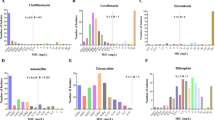Abstract
Resistance to metronidazole (Met), clarithromycin (Cla) and amoxycillin (Amo) was examined usingH. pylori isolates from child patients before and after treatment in the period 1997–2001. The rate of Met and Cla resistance before treatment was 35.2 and 8.6 %, respectively. Six weeks after treatment 48.4 % of the isolated strains were resistant to Met and 17.6 % to Cla. The highest rate of resistance to both antibiotics was determined in 2001 (before treatment, 46 and 15 %, respectively, and after treatment, 57.8 and 26.3 %, respectively). All the strains were susceptible to Amo. Strains resistant to Met were detected more frequently in girls than in boys.
Similar content being viewed by others
Abbreviations
- Amo:
-
amoxycillin
- Cla:
-
clarithromycin
- Met:
-
metronidazole
- Ome:
-
omeprazole
References
Alarcón T., Vega A.E., Domingo D., Martinez M.J., López-Brea M.: Clarithromycin resistance amongHelicobacter pylori strains isolated from children: prevalence and study of mechanism of resistance by PCR-restriction fragment length polymorphism analysis.J.Clin.Microbiol. 41, 486–499 (2003).
Boyanova L., Stancheva I., Spassova A., Katzarov N., Mitov I., Koumanova R.: Primary and combined resistance to four anti-microbial agents inHelicobacter pylori in Sofia (Bulgaria).J.Med.Microbiol. 49, 415–418 (2000).
Cabrita J., Oleastro M., Matos R., Manhente A., Cabral J., Barros R., Lopes A.I., Ramalho P., Neves B.C., Guerreiro A.S.: Features and trendsin Helicobacter pylori antibiotic resistance in Lisbon area (Portugal) 1990–1999.J.Antimicrob.Chemother. 46, 1029–1031 (2000).
Crone J., Granditsch G., Huber W.D., Binder C., Innerhofer A., Amann G., Hirschl A.M.:Helicobacter pylori in children and adolescents: increase of primary clarithromycin resistance, 1997–2000.J.Pediatr.Gastroenterol.Nutr. 36, 368–371 (2003).
Dore M.P., Piana A., Carta M., Atzei A., Are B.M., Mura I., Massarelli G., Maida A., Sepulveda A.R., Graham D.Y., Realdi G.: Amoxycillin resistance is one reason for failure of amoxycillin-omeprazole treatment ofHelicobacter pylori infection.Aliment.Pharmacol.Ther. 12, 635–639 (1998).
Glupczynski Y.: European Study Group on antibiotic susceptibility ofHelicobacter pylori: results of a multicentre European survey in 1991 of metronidazole resistance inH. pylori.Eur.J.Clin.Microbiol.Infect.Dis. 11, 777–781 (1992).
Heep M., Kist M., Strobel S., Beck D., Lehn N.: Secondary resistance among 554 isolates ofHelicobacter pylori after failure of therapy.Eur.J.Clin.Microbiol.Infect.Dis. 19, 538–541 (2000).
Kalach N., Bergeret M., Benhamou P.H., Dupont C., Raymond J.: High levels of resistance to metronidazole and clarithromycin inHelicobacter pylori strains in children.J.Clin.Microbiol. 39, 394–397 (2001).
Kato M., Yamaoka Y., Kim J.J., Reddy R., Asaka M., Kashima K., Osato M.S., El-Zaatari F.A., Graham D.Y., Kwon D.H.: Regional differences in metronidazole resistance and increasing clarithromycin resistance amongHelicobacter pylori isolates from Japan.Antimicrob.Agents Chemother. 44, 2214–2216 (2000).
Marais A., Bilardi C., Cantet F., Mendz G.L., Megraud F.: Characterization of the genesrdxA andfrxA involved in metronidazole resistance inH. pylori.Res.Microbiol. 154, 137–144 (2003).
Mentis A.F., Roma E., Pangalis A., Katsiyiannakis E.: Susceptibilities ofHelicobacter pylori strains isolated from children with gastritis to selected antibiotics.J.Antimicrob.Chemother. 44, 720–722 (1999).
Rożynek E., Dzierżanowska-Fangrat K., Celińska-Cedro D., Jóżwiak P., Madalinski K., Dzierżanowska D.: Primary resistance ofHelicobacter pylori to antimicrobial agents in Polish children.Acta Microbiol.Polon. 51, 255–263 (2002).
Vaira D., Holton J., Ricci C., Gatta L., Tampieri A., Miglioli M.:Helicobacter pylori infection from pathogenesis treatment — a critical reappraisal (review).Aliment.Pharmacol.Ther. 16, 105–113 (2002).
Van Doorn L.J., Glupczynski Y., Kusters J.G., Megraud F., Maggi-Solca N., Queiroz D.M., Nouhan N., Stet E., Quint W.G.: Accurate prediction of macrolide resistance inHelicobacter pylori by a PCR line probe assay for detection of mutations in the 23S rRNA gene: multicenter validation study.Antimicrob.Agents Chemother. 45, 1500–1504 (2001).
Wang W.H., Wong B.C., Mukhopadhyay A.K., Berg D.E., Cho C.H., Lai K., Hu W.H., Fung F.M., Hui W.M., Lam S.K.: High prevalence ofHelicobacter pylori infection with dual resistance to metronidazole and clarithromycin in Hong Kong.Aliment.Pharmacol.Ther. 14, 901–910 (2000).
Wu H., Shi X.D., Wang H.T., Liu J.X.: Resistance ofHelicobacter pylori to metronidazole, tetracycline and amoxycillin.J.Antimicrob.Chemother. 46, 121–123 (2000).
Author information
Authors and Affiliations
Rights and permissions
About this article
Cite this article
Gościniak, G., Iwańczak, B., Przondo-Mordarska, A. et al. High level of resistance to metronidazole and clarithromycin inHelicobacter pylori isolated from pediatric patients in Poland (1997–2001). Folia Microbiol 49, 133–136 (2004). https://doi.org/10.1007/BF02931386
Received:
Revised:
Issue Date:
DOI: https://doi.org/10.1007/BF02931386




